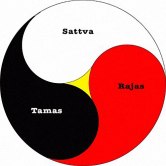Three Visual Representations of the Gunas



According to the Bhagavad Gita, the gunas (the primary qualities or modes of Nature) are three in number, sattva, rajas and tamas. They exist in all, including humans, in various degrees of concentration and combination. They also exist in all objects and natural products.
1. Sattva is pure, without impurities, illuminating and free from sickness. It binds the soul through attachment with happiness and knowledge.
2. Rajas is full of passion and is born out of “thrishna” (thirst or intense desire) and “sanga” (attachment). It binds the soul through attachment with action.
3. Tamas is the darkness and the crudeness in man. It is “ajnanajam” (born of ignorance) and “mohanam” (the cause of delusion). It binds the soul through recklessness, indolence and sleep.
In the beings the three gunas compete among themselves for supremacy and try to suppress each other. Sattva predominates by suppressing Rajas and Tamas. Rajas predominates by suppressing Sattva and Tamas, and Tamas by suppressing both Sattva and Rajas.
The Bhagavad Gita suggests that we should try to transcend them rather than cultivate them. By knowing the nature of the three gunas and how they tend to keep us in bondage and illusion, we should become wiser and strive to transcend them. Sattva is purity and beneficial. However, for those who strive for liberation, even cultivation of “sattva” should be not an end in itself for sattva also binds us to the duality of pleasure and pain. Sattvic people want to enjoy pleasure and avoid pain. They are pious and knowledgeable but prefer leading a life of luxury and comfort. Thereby, they engage in desire-ridden actions and become bound. Even though it is pure, sattva is but an instrument of Prakriti, which is meant to serve its ends by keeping us bound to the worldly life under the sovereign control of its sovereign master. Hence, one may cultivate purity (sattva) to suppress the other two, but in the end must rise above all the three and become stabilized in equanimity, sameness, and oneness of the Self. One should go beyond the three gunas to attain immortality and freedom from birth, death, old age and sorrow.
When a person overcomes the three gunas, he neither likes nor dislikes purity light, passion and delusion, which are the predominant modalities that arise from the gunas namely sattva, rajas and tamas respectively. He does not detest them when they are present nor desires them when they are absent. He remains indifferent, undisturbed by the gunas, knowing that it is the gunas which are acting in all beings but not the Self which is present in them. Therefore, he remains alike in pleasure and pain, stable and equal towards a lump of earth or gold, the pleasant and the unpleasant, criticism or praise, honor or dishonor, and friend or foe. Since he rises above the gunas, he does not take sides in any dispute, show any favor or preference for the dualities of life and renounces the ambition and the initiative to perform tasks.